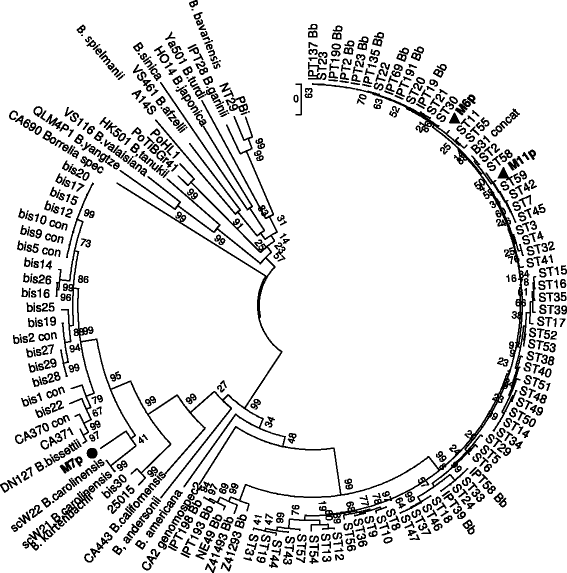A divergent spirochete strain isolated from a resident of the southeastern United States was identified by multilocus sequence typing as Borrelia bissettii
- PMID: 26846867
- PMCID: PMC4743114
- DOI: 10.1186/s13071-016-1353-4
A divergent spirochete strain isolated from a resident of the southeastern United States was identified by multilocus sequence typing as Borrelia bissettii
Abstract
Background: Out of 20 spirochete species from Borrelia burgdorferi sensu lato (s.l.) complex recognized to date some are considered to have a limited distribution, while others are worldwide dispersed. Among those are Borrelia burgdorferi sensu stricto (s.s.) and Borrelia bissettii which are distributed both in North America and in Europe. While B. burgdorferi s.s. is recognized as a cause of Lyme borreliosis worldwide, involvement of B. bissettii in human Lyme disease was not so definite yet.
Findings: Multilocus sequence typing of spirochete isolates originating from residents of Georgia and Florida, USA, revealed the presence of two Borrelia burgdorferi sensu stricto strains highly similar to those from endemic Lyme borreliosis regions of the northeastern United States, and an unusual strain that differed from any previously described in Europe or North America. Based on phylogenetic analysis of eight chromosomally located housekeeping genes divergent strain clustered between Borrelia bissettii and Borrelia carolinensis, two species from the B.burgdorferi s.l. complex, widely distributed among the multiple hosts and vector ticks in the southeastern United States. The genetic distance analysis showed a close relationship of the diverged strain to B. bissettii.
Conclusions: Here, we present the analysis of the first North American human originated live spirochete strain that revealed close relatedness to B. bissettii. The potential of B. bissettii to cause human disease, even if it is infrequent, is of importance for clinicians due to the extensive range of its geographic distribution.
Figures

Similar articles
-
Genetic heterogeneity of Borrelia burgdorferi sensu lato in the southern United States based on restriction fragment length polymorphism and sequence analysis.J Clin Microbiol. 2001 Jul;39(7):2500-7. doi: 10.1128/JCM.39.7.2500-2507.2001. J Clin Microbiol. 2001. PMID: 11427560 Free PMC article.
-
Genetic diversity of the outer surface protein C gene of southern Borrelia isolates and its possible epidemiological, clinical, and pathogenetic implications.J Clin Microbiol. 2002 Jul;40(7):2572-83. doi: 10.1128/JCM.40.7.2572-2583.2002. J Clin Microbiol. 2002. PMID: 12089279 Free PMC article.
-
Isolation of live Borrelia burgdorferi sensu lato spirochaetes from patients with undefined disorders and symptoms not typical for Lyme borreliosis.Clin Microbiol Infect. 2016 Mar;22(3):267.e9-15. doi: 10.1016/j.cmi.2015.11.009. Epub 2015 Dec 8. Clin Microbiol Infect. 2016. PMID: 26673735
-
Updates on Borrelia burgdorferi sensu lato complex with respect to public health.Ticks Tick Borne Dis. 2011 Sep;2(3):123-8. doi: 10.1016/j.ttbdis.2011.04.002. Epub 2011 May 27. Ticks Tick Borne Dis. 2011. PMID: 21890064 Free PMC article. Review.
-
Molecular typing of Borrelia burgdorferi sensu lato: taxonomic, epidemiological, and clinical implications.Clin Microbiol Rev. 1999 Oct;12(4):633-53. doi: 10.1128/CMR.12.4.633. Clin Microbiol Rev. 1999. PMID: 10515907 Free PMC article. Review.
Cited by
-
Unexpected failure of Ixodes scapularis nymphs to transmit a North American Borrelia bissettiae strain.Curr Res Parasitol Vector Borne Dis. 2021 Jul 3;1:100039. doi: 10.1016/j.crpvbd.2021.100039. eCollection 2021. Curr Res Parasitol Vector Borne Dis. 2021. PMID: 35284869 Free PMC article.
-
PCR Detection of Bartonella spp. and Borreliella spp. DNA in Dry Blood Spot Samples from Human Patients.Pathogens. 2024 Aug 28;13(9):727. doi: 10.3390/pathogens13090727. Pathogens. 2024. PMID: 39338918 Free PMC article.
-
Line Immunoblot Assay for Tick-Borne Relapsing Fever and Findings in Patient Sera from Australia, Ukraine and the USA.Healthcare (Basel). 2019 Oct 21;7(4):121. doi: 10.3390/healthcare7040121. Healthcare (Basel). 2019. PMID: 31640151 Free PMC article.
-
Red Foxes (Vulpes vulpes) Are Exposed to High Diversity of Borrelia burgdorferi Sensu Lato Species Infecting Fox-Derived Ixodes Ticks in West-Central Poland.Pathogens. 2022 Jun 16;11(6):696. doi: 10.3390/pathogens11060696. Pathogens. 2022. PMID: 35745549 Free PMC article.
-
Detection of Lyme Disease Bacterium, Borrelia burgdorferi sensu lato, in Blacklegged Ticks Collected in the Grand River Valley, Ontario, Canada.Int J Med Sci. 2017 Feb 8;14(2):150-158. doi: 10.7150/ijms.17763. eCollection 2017. Int J Med Sci. 2017. PMID: 28260991 Free PMC article.
References
-
- Rijpkema SG, Tazelaar DJ, Molkenboer MJ, Noordhoek GT, Plantinga G, Schouls LM, et al. Detection of Borrelia afzelii, Borrelia burgdorferi sensu stricto, Borrelia garinii and group VS116 by PCR in skin biopsies of patients with erythema migrans and acrodermatitis chronica atrophicans. Clin Microbiol Infect. 1997;3:109–116. doi: 10.1111/j.1469-0691.1997.tb00259.x. - DOI - PubMed
-
- Ryffel K, Péter O, Rutti B, Suard A, Dayer E. Scored antibody reactivity determined by immunoblotting shows an association between clinical manifestations and presence of Borrelia burgdorferi sensu stricto, B. garinii, B. afzelii, and B. Valaisiana in humans. J Clin Microbiol. 1999;37:4086–4092. - PMC - PubMed
Publication types
MeSH terms
LinkOut - more resources
Full Text Sources
Other Literature Sources
Medical

